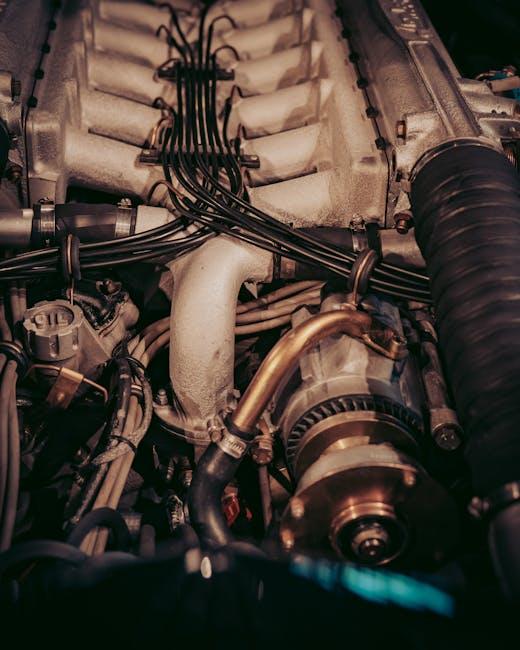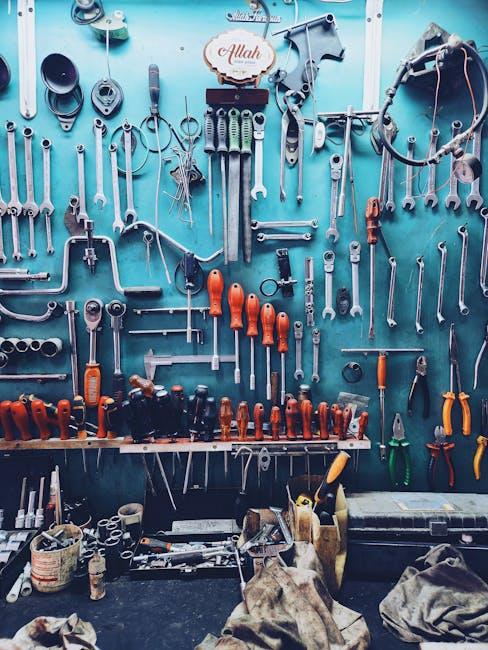When your car starts making that mysterious noise or the check engine light flickers on, a crucial question revs up in your mind: should you roll up your sleeves and tackle the problem yourself, or hand the keys over to a professional mechanic? The world of auto repair splits into two distinct lanes—DIY enthusiasts armed with tools and tutorials, and seasoned experts equipped with experience and specialized equipment. Navigating this crossroad involves weighing factors such as cost, convenience, skill level, and safety. In this article, we’ll explore the pros and cons of DIY versus professional auto repair, helping you decide which route best suits your needs and keeps your vehicle running smoothly.
Table of Contents
- Understanding the Complexity of Auto Repairs and When to Call a Pro
- Evaluating Cost Factors: DIY Savings Versus Professional Investment
- Safety Considerations That Make or Break Your Repair Choice
- Tools and Skills Required for Successful Do It Yourself Repairs
- Quality Control and Warranty Implications in Auto Maintenance
- Making the Right Decision Based on Your Vehicle and Repair Needs
- Q&A
- The Way Forward

Understanding the Complexity of Auto Repairs and When to Call a Pro
Modern vehicles are intricate machines, comprising thousands of interconnected parts that rely on precision engineering. While some repairs like changing a flat tire or topping up fluids can be straightforward, many issues hide beneath the hood, requiring advanced diagnostic tools and expertise. Attempting repairs without the proper knowledge often leads to more harm than good, turning minor fixes into costly headaches. Recognizing the limits of your skills and understanding the complexity of modern auto systems, such as computerized engine controls and advanced safety features, is key to deciding when to tackle a job yourself and when to hand the keys over to a professional.
Knowing when to call a professional can save you time, money, and frustration. If you encounter any of the following signs, it’s wise to seek expert assistance:
- Warning lights: Persistent or flashing dashboard alerts, such as the check engine light.
- Unusual sounds: Grinding, knocking, or squealing noises that don’t subside.
- Performance issues: Reduced power, stalling, or irregular idling.
- Complex systems: Problems involving the transmission, brakes, or electrical wiring.
| Repair Type | DIY Feasibility | Professional Recommended |
|---|---|---|
| Oil Change | High | Optional |
| Brake Pad Replacement | Moderate | Recommended |
| Engine Diagnostics | Low | Essential |
| Transmission Repair | Very Low | Essential |

Evaluating Cost Factors: DIY Savings Versus Professional Investment
When weighing the financial implications of fixing your car, the appeal of DIY savings can be strong. The immediate costs appear significantly lower—you’re mostly paying for parts and basic tools. This route can be particularly economical if you already have the necessary equipment on hand or are tackling minor repairs. However, it’s important to consider hidden costs like your time investment, potential mistakes that could worsen the issue, and the learning curve associated with diagnosing problems accurately.
On the other hand, investing in a professional mechanic often means paying a premium upfront, but it can translate to long-term savings through expertise, efficiency, and access to specialized tools. Professionals generally offer warranties and guarantees that protect you against future expenses related to the same repair. Below is a breakdown of common cost factors to consider when deciding between DIY and professional repairs:
| Cost Factor | DIY Approach | Professional Mechanic |
|---|---|---|
| Labor | Free (your time) | Charged by hour |
| Tools & Equipment | Initial purchase or ongoing upgrades | Included in service |
| Parts | Buy wholesale or retail | Markup possible |
| Risk of Error | High without experience | Low due to expertise |
| Warranty | No | Usually provided |

Safety Considerations That Make or Break Your Repair Choice
When it comes to auto repairs, safety should be your compass guiding every decision. Taking on a repair project yourself without the right tools or knowledge can turn a minor issue into a major hazard. Improperly fixed brakes, faulty electrical work, or poorly aligned components don’t just compromise your vehicle’s performance—they endanger lives on the road. Professionals bring certified expertise, access to advanced diagnostic equipment, and a deep understanding of safety protocols that DIYers may lack. Even seemingly simple tasks like changing spark plugs or replacing brake pads carry risks of injury or further damage if not done correctly.
Consider these key safety factors before deciding who handles your repair:
- Complexity of the task: Some repairs require specialized knowledge beyond the scope of most DIYers.
- Proper tools and protective gear: Professionals use calibrated tools and safety equipment to mitigate risks.
- Liability and warranties: Certified mechanics often provide warranties and insurance, offering peace of mind.
- Environmental safety standards: Proper disposal of hazardous materials is crucial—and often regulated.
| Safety Aspect | DIY Risks | Professional Advantages |
|---|---|---|
| Tool Use | Improper or inadequate tools | Specialized, calibrated equipment |
| Knowledge | Limited troubleshooting ability | Certified training and experience |
| Warranty | None; risk of voiding parts warranty | Often includes repair warranty |
| Environmental Disposal | Potential for improper disposal | Meets legal disposal standards |

Tools and Skills Required for Successful Do It Yourself Repairs
Embarking on a DIY auto repair journey demands more than just enthusiasm; it requires a specific set of tools and skills to ensure safety and effectiveness. At the very least, every aspiring home mechanic should arm themselves with a basic tool kit that includes a socket set, screwdrivers, pliers, a torque wrench, and a quality jack with stands. Precise measurement instruments like a multimeter or a tire pressure gauge can also make diagnostics far easier, turning guesswork into informed repairs. Besides tools, familiarizing yourself with your vehicle’s service manual and repair tutorials can make the difference between a successful fix and a costly mistake.
However, mastering the necessary skills is equally crucial; technical aptitude grows through patience and practice. Knowing how to safely lift and secure a vehicle, interpret error codes from onboard diagnostics, and apply correct torque specifications can elevate your confidence and competence. To help you evaluate your readiness, here is a quick overview of essential tools against fundamental skills:
| Essential Tools | Core Skills |
|---|---|
| Socket and Wrench Sets | Mechanical Aptitude |
| Torque Wrench | Reading Service Manuals |
| Screwdrivers (Flat & Philips) | Basic Electrical Diagnosis |
| Car Jack and Jack Stands | Safe Lifting and Support |
| Multimeter | Interpreting Diagnostic Codes |

Quality Control and Warranty Implications in Auto Maintenance
When it comes to maintaining your vehicle, the distinction between DIY repairs and professional services heavily influences the overall quality control and warranty standing of your auto. Professional mechanics typically employ rigorous diagnostic tools and adhere to manufacturer-recommended standards, ensuring precision and reliability. This level of meticulous attention reduces the risk of premature wear or future failures, offering peace of mind that your vehicle’s integrity remains uncompromised.
On the flip side, DIY repairs may void warranties if manufacturers detect unapproved parts or improper installation, potentially leading to costly disputes. Here are some critical considerations to keep in mind:
- Use of OEM vs aftermarket parts – OEM parts generally protect warranty validity.
- Documentation – Professional garages provide detailed service records, useful in claims.
- Specialized tools and skills – Ensure repairs meet safety and performance criteria.
| Aspect | DIY | Professional Repair |
|---|---|---|
| Warranty Impact | Risk of voiding | Preserved with certified service |
| Quality Assurance | Depends on skill level | Consistently high standards |
| Documentation | Often minimal or none | Comprehensive and traceable |

Making the Right Decision Based on Your Vehicle and Repair Needs
Deciding between tackling a repair yourself or consulting a professional hinges on several critical aspects of your vehicle and the complexity of the issue. For modern cars equipped with intricate electronics, advanced safety features, or hybrid components, professional expertise is often necessary to ensure repairs are done correctly without compromising the vehicle’s integrity. On the other hand, if you drive an older model with straightforward mechanical systems, some repairs like replacing brake pads or changing oil can be manageable with the right tools and instructions.
Before diving into repairs, evaluate your skill level, the tools required, and the potential risks involved. Consider the following checklist to guide your decision:
- Complexity of the repair: Is it a simple fix or does it require specialized knowledge?
- Tools and equipment: Do you have access to the proper diagnostic and repair tools?
- Time commitment: Can you afford the hours a DIY project might consume?
- Warranty and insurance impacts: Will self-repair void any warranties or insurance coverage?
- Safety concerns: Are there risks involved that warrant professional handling?
| Factor | DIY | Professional Repair |
|---|---|---|
| Cost | Lower upfront (tools purchase may vary) |
Higher but includes expertise |
| Skill Required | Moderate to High | Expert-Level |
| Time | Flexible, potentially longer | Usually faster, scheduled appointments |
| Quality Assurance | Variable | Reliable & guaranteed |
Q&A
Q: What are the main benefits of choosing DIY auto repair?
A: DIY auto repair can save you money on labor costs, provide a sense of accomplishment, and increase your understanding of how your vehicle works. It’s a great option for minor fixes and routine maintenance if you have the right tools, time, and willingness to learn.
Q: When is professional auto repair a better choice than DIY?
A: Professional repair is recommended for complex problems, safety-related issues, or when specialized diagnostic equipment is required. Mechanics have the expertise, experience, and warranties that provide peace of mind, especially for critical repairs.
Q: What risks do I face with DIY auto repair?
A: Without proper knowledge, you risk making the problem worse, compromising vehicle safety, or damaging expensive parts. Incorrect repairs can lead to costly follow-up fixes or even accidents, so it’s important to recognize your skill limits.
Q: How do I decide if a repair is within my DIY skill level?
A: Assess the complexity—simple jobs like changing oil, replacing air filters, and swapping brake pads are usually manageable. If the task involves the engine, transmission, or electrical systems, or if you feel uncertain, it’s safer to seek professional help.
Q: Is there a middle ground between DIY and professional repair?
A: Absolutely. Some car owners do partial repairs themselves—like prepping or disassembling parts—and then bring the vehicle to a professional for advanced work. This hybrid approach can reduce costs while ensuring accuracy and safety.
Q: How can I prepare myself for DIY auto repair?
A: Start by studying your vehicle’s manual and credible repair guides, watching tutorial videos, and investing in basic tools. Take on smaller projects first to build confidence and skill before attempting more complex repairs.
Q: Does the age or type of my car affect the DIY vs. professional decision?
A: Yes. Older or less complex vehicles might be easier to work on yourself, while newer cars with advanced electronics and proprietary parts often require professionals. Exotic or high-performance vehicles usually demand expert attention to maintain value and function.
Q: What role does cost play in choosing between DIY and professional repairs?
A: Cost is a big factor. DIY can save money on labor but may require upfront investment in tools and parts. Professionals may charge more but provide diagnostics, warranties, and efficient service—sometimes preventing costly mistakes.
Q: Can technology and online resources improve my DIY success?
A: Definitely. Online forums, video tutorials, and diagnostic apps offer invaluable help, turning your smartphone into a virtual mechanic. However, use multiple sources and verify information to avoid following unsafe advice.
Q: Ultimately, how should I decide between doing it myself or going to a pro?
A: Balance your comfort level, knowledge, tools, safety considerations, and the complexity of the repair. When in doubt, professional expertise is a worthy investment, but if you enjoy learning and your project is manageable, DIY can be rewarding and cost-effective.
The Way Forward
In the end, the choice between DIY and professional auto repair boils down to more than just tools and talent—it’s a balance of time, confidence, and the value you place on peace of mind. Whether you roll up your sleeves in the garage or hand over the keys to a trusted expert, each path offers its own rewards and challenges. So, the next time your car needs a fix, pause and consider: is this a journey you want to navigate yourself or one you’d rather entrust to seasoned hands? Whichever road you choose, may it lead you safely back on the open highway.
